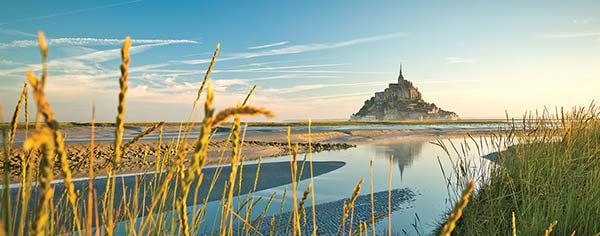
Map: PLACES COVERED IN THIS BOOK
Whirlwind Three-Week Tour of France by Car
Whirlwind Three-Week Tour of France by Train (and Bus)
Stick This Guidebook in Your Ear!
The Language Barrier and That French Attitude
Bienvenue! You’ve chosen well. With its distinctive regions and renowned cuisine, France is Europe’s most diverse, tasty, and exciting country to explore. It’s a cultural bouillabaisse that surprises travelers with its varied, complex flavors.
A delightful blend of natural and man-made beauty, France offers chandeliered châteaux, forever coastlines, soaring cathedrals, Europe’s highest mountain ranges, and museums showcasing cultural icons of the Western world.
In many ways, France is a yardstick of human achievement. Here, travelers can trace the path of European history, from magnificent prehistoric cave paintings to dazzling Roman ruins. In medieval times, France cultivated Romanesque and Gothic architecture—erecting towering cathedrals and inspiring copycat trends throughout Europe. With revolutionary zeal, French philosophers refined modern thought and politics. In the 16th and 17th centuries, the châteaux of the Loire and the grand palace of Versailles announced France’s emergence as the first European superpower and first modern government. Later France gave birth to Impressionism and with that, the foundations of modern art. And the country remains at the forefront of technology, architecture, fashion, and cuisine.
France is a big country by European standards—and would be one of the biggest states if it ever joined the US (unlikely). It’s a bit smaller than Texas, but has 66 million people (Texas has 26 million). This country features three mountain ranges, two very different coastlines, several cosmopolitan cities, and countless sleepy villages.
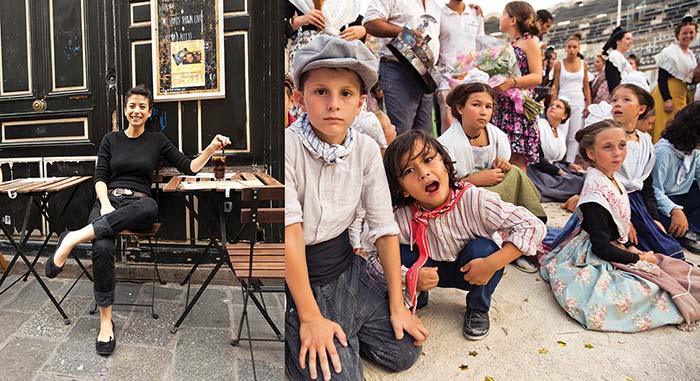
From chic attire (in Paris) to tradi-tional garb (at a festival in Arles), the French wear it well.
There are two Frances: Paris...and the rest of the country. France’s government and cultural heart have always been centered in Paris, resulting in an overwhelming concentration of world-class museums, cutting-edge architecture, historic monuments, trendy energy, and famous cafés. Travelers can spend weeks in France and never leave Paris. Many do.
The other France venerates land, tradition, and a slower pace of life. Romantic hill towns and castles, meandering river valleys, and oceans of vineyards carpet this country’s landscape. Wheat farms flourish in the north, dairy farms in the west, fruit orchards and lavender fields in the south...and vineyards and sunflowers just about everywhere. Even city dwellers venerate the soil (le terroir) that brings the flavor to their foods and wines.
France has more geographical diversity than any other nation in Europe. Paris and the land around it (called Ile de France) is the modern, bustling center. To the west are the dramatic D-Day beaches and thatch-roofed homes of Normandy; to the south lie the river valleys of the Loire and Dordogne, with elegant châteaux, medieval castles, and hilltop villages. In the far southwest are the Spanish-tinged Languedoc-Roussillon and the overlooked Pyrenees. Closer to Italy, windswept Provence nurtures Roman ruins and rustic charm, while the Riviera celebrates sunny beaches and modern art. And to the east are Europe’s highest snow-capped Alps, the vineyards of Burgundy, and the Germanic culture of Alsace.
The country is famous for its pâtés, foie gras, escargot, fine sauces, cheese (more than 350 different kinds), and delectable pastries. But the forte of French cuisine lies in its regional variety. You’ll enjoy Swiss-like fondue in the Alps, Italian-style pasta on the Riviera, crêpes in Brittany, Spanish paella in Languedoc-Roussillon, seafood in Normandy, and sausage and sauerkraut in Alsace.
L’art de vivre—the art of living—is not just a cute expression; it’s the foundation for good living in France. With five weeks of paid vacation, the French are obligated to slow down and enjoy life. It’s no accident that the country is home to pastimes like café lounging, bike touring, barge cruising, and ballooning—all require a slower pace. You’ll run headlong into that mindful approach to life at mealtime. The French insist on quality food and conversation. They don’t rush lunch, and an evening’s entertainment is often a meal with friends.
The socially minded French are proud of their cradle-to-grave social security system. On the other hand, French taxes are among the highest in Europe. The country sees more than its share of strikes, demonstrations, and slowdowns as workers try to preserve their hard-earned rights in a competitive global economy. Mainly Catholic, the French are not very devout, and are quick to separate church from state. France also has Europe’s largest Muslim population. The influx of Muslim immigrants and their integration in French society is one of France’s thorniest issues.
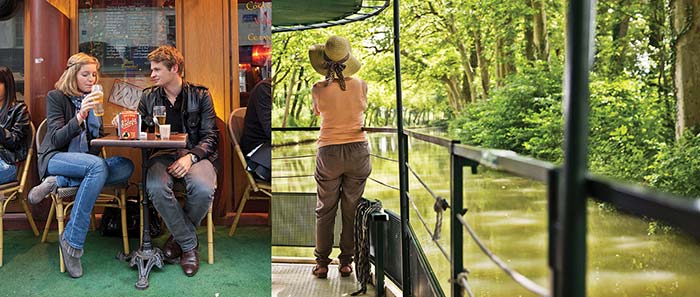
Whether meeting a friend or cruising on a barge, the French cultivate the art of living.
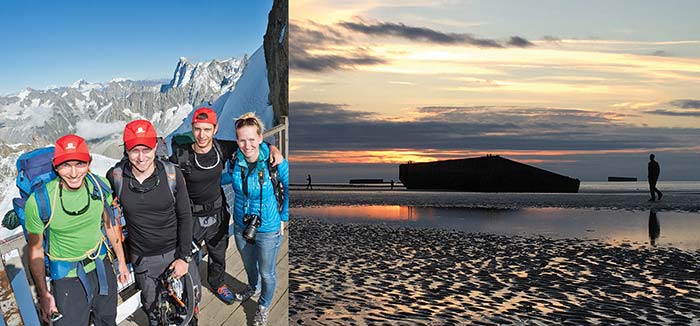
France has Alps to inspire and D-Day beaches to ponder.
French people can come across as moody and compli-cated, though most will welcome you with a smile. Still, think where they’ve come from: In just a few generations, they’ve seen two debilitating world wars destroy their cities, villages, landscapes, and self-respect. But proud and resilient, they have risen from the ashes of the wars to generate the world’s sixth-largest economy. Wine, agriculture, tourism, telecommunications, pharmaceuticals, cars, and Airbus planes are big moneymakers. Productivity is nothing new to a people who invented the metric system, pasteurization, high-speed trains, and the Concorde jet.
Highly cultured yet down to earth, France is fascinating. From the Swiss-like Alps to the molto Italian Riviera, and from the Spanish Pyrenees to das German Alsace, you can visit France and feel like you’ve sampled much of Europe—and never be more than a short stroll from a bon vin rouge.
Mon Dieu! There’s so much to see in France and so little time. This overview breaks the country’s top destinations into must-see sights (to help first-time travelers plan their trip) and worth-it sights (for those with extra time or special interests), listed in book order. I’ve also suggested a minimum number of days to allow per destination.
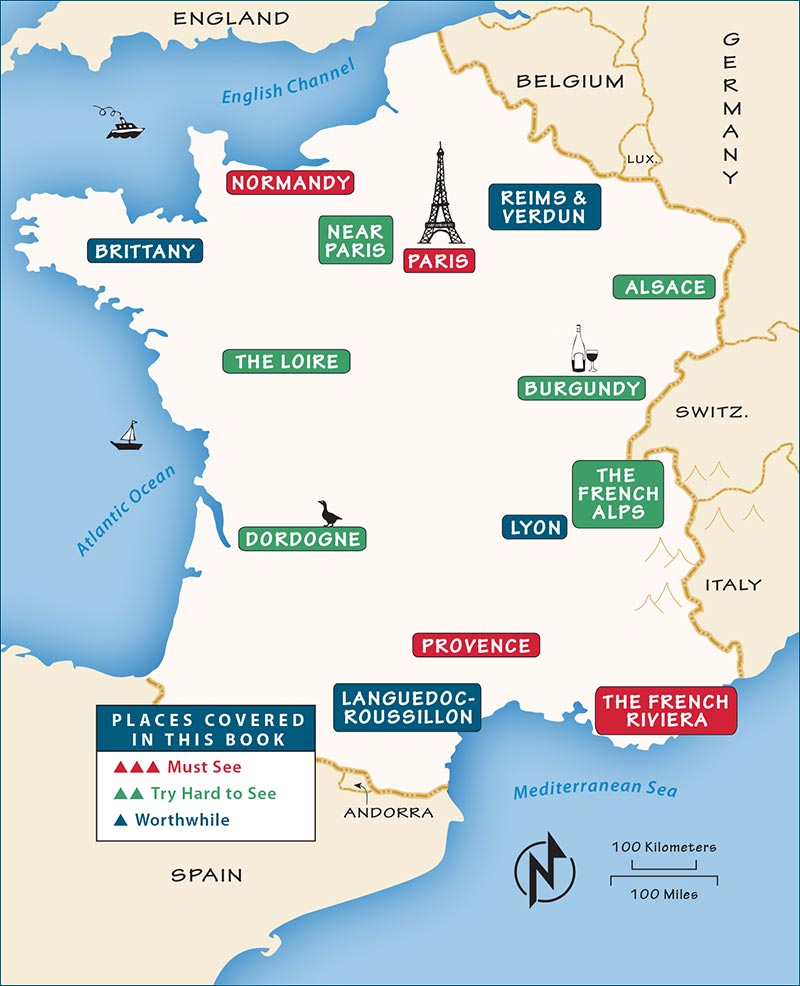
The magical city of Paris, historic Normandy, the sun-dappled region of Provence, and the breathtaking Riviera coastline offer an excellent sampler of France.
The City of Light is not only the capital of France, but also the world capital of art, fashion, food, literature, and ideas, offering historic monuments, grand boulevards, corner cafés, chic boutiques, avant-garde architecture, and top-notch art galleries, including the Louvre (Venus de Milo and Mona Lisa) and the Orsay (Impressionists and more).
This region offers a pastoral mix of sweeping coastlines, half-timbered towns, and intriguing cities, including bustling Rouen (Gothic architecture and Joan of Arc sites), the cozy port town of Honfleur, and historic Bayeux (with its remarkable tapestry of the Battle of Hastings). Normandy’s D-Day beaches and museums are profoundly moving, while the almost surreal island abbey of Mont St-Michel seems to float above it all.
This beloved, hilly region is home to the cities of Arles (with Van Gogh sights and the evocative Roman Arena), Avignon (with the famous bridge and Palace of the Popes), and Orange (Roman theater), plus photogenic rock-top villages (such as Les Baux, Roussillon, and Vaison-la-Romaine). Attractions include the simply awe-inspiring Roman aque-duct of Pont du Gard and the inviting wine road of the Côtes du Rhône.
A Montmartre café scene in Paris, the American Cemetery and Memorial at Omaha Beach, the historic Bayeux tapestry, and the Roman Arena in Arles
Along the Riviera lies a string of coastal pearls, starring Nice (big city with a lively seafront promenade, Italianesque old town, and art museums), romantic Villefranche-sur-Mer, glitzy Monaco (casino and Prince’s Palace), and easygoing Antibes (silky-sandy beaches and seafront hikes). Intriguing inland villages are Vence, St-Paul-de-Vence, and sky-high Eze-le-Village, with marvelous Mediterranean views.

Opposite: Monet’s flowery gardens at Giverny
This page: A Riviera moment, canoeing on the Dordogne, and beautiful Amboise
You can weave any of these destinations—rated ▲ or ▲▲—into your itinerary. Some places are easy to add based on proximity (if you’re going to Paris, Versailles is next door), but even out-of-the-way destinations can merit the journey, depending on your time and interests.
Four very different sights make good day trips from Paris: Europe’s grandest palace at Versailles, the radiant cathedral of Chartres, Monet’s flowery gardens at Giverny, and a mouse-run amusement park (Disneyland Paris).
Windswept, rugged Brittany has an untouristed interior, gorgeous coast, Celtic ties, and two notable towns—Dinan (with Brittany’s best medieval center) and the beach resort of St-Malo—plus the sea-swept castle of Fort la Latte.
The river valleys of the Loire region host appealing towns (such as Amboise and Chinon) and hundreds of castles and palaces, including Chenonceau (arcing across its river), the massive Château de Chambord, Villandry (wonderful gardens), lavishly furnished Cheverny, and many more.
Prehistoric caves, rock-sculpted villages, lazy canoe rides past medieval castles, and bustling market towns such as pedestrian-friendly Sarlat-la-Canéda are among this region’s charms. Just east is the spectacular pilgrimage village of Rocamadour, and to the west is St-Emilion, with vineyards and tastings.
This sunny region with a Spanish flair boasts the medieval, walled town of Carcassonne (with towers, turrets, and cobblestones) and the lovely Mediterranean village of Collioure. Albi makes a good stop for its fortress-like cathedral and beautiful Toulouse-Lautrec museum.
These majestic mountains feature the beautiful lakefront city of Annecy, Mont Blanc (Europe’s highest peak), and the world-famous ski resort at its base, Chamonix, with lifts to stunning alpine views and trailheads, and hikes galore.
An aged blend of vineyards and spirituality, Burgundy is home to the compact town of Beaune, renowned vineyards and wine roads, the well-preserved medieval abbey of Fontenay, the magnificent Romanesque church of Vézelay, and a medieval castle under construction at Guédelon.
This metropolitan city, wedged between Burgundy and Provence, features delicious yet affordable cuisine, a made-for-wandering old town, two Roman theaters, a terrific Gallo-Roman museum, the riveting French Resistance Center, and an impressive fine arts museum.
The Franco-Germanic region is dotted with adorable and colorful wine villages, half-timbered Colmar with a wonderful pedestrian-only center and world-class art, and the high-powered Euro-capital city of Strasbourg and its sensational cathedral.
Two very different sights, paired by proximity, are the champagne-soaked city of Reims with its historic cathedral and cellars serving the sparkling brew, and nearby Verdun, the site of horrific WWI battles, with unforgettable battlefield memorials and museums.
Carcassonne’s castle walls, dining under medieval arches in Beaune, lovely lakeside Annecy, and cute wine villages along Alsace’s Route du Vin
To plan your trip, you’ll need to design your itinerary—choosing where and when to go, how you’ll travel, and how many days to spend at each destination. For more-detailed advice on sightseeing, accommodations, restaurants, and transportation, see the Practicalities chapter.
As you read this book and learn your options...
The recommended whirlwind trip (on here) gives you an idea of how much you could see in 22 days, but it’s best to adapt it to fit your interests and time frame.
Nearly every destination in this book can enjoyably fill a week or more of a focused trip, especially Paris, Normandy, the Loire, the Dordogne, Provence, and the French Riviera. Linking any two or three of these destinations would make a terrific trip.
France has something for everyone. Art lovers and museum-goers linger in Paris. Cyclists pedal between châteaux in the Loire, and canoeists paddle between castles in the Dordogne. Connoisseurs of wine and villages meander along the wine roads of Burgundy, Alsace, and the Côtes du RhÔne.
Historians are at home in France. The Dordogne’s prehistoric cave paintings literally rock. For ancient Roman ruins, roam through Provence. Medievalists marvel at the walled town of Carcassonne and the island abbey of Mont St-Michel. Revolutionaries and monarchists alike appreciate Paris and Versailles. WWII historians make a pilgrimage to Normandy’s D-Day sites, while WWI students ponder Verdun.
Sun worshippers simmer on the Riviera while hikers love to go a-wandering in the Alps. If hill towns and sunny skies appeal, Provence and Languedoc deliver. Germanophiles think Alsace is wunderbar, foodies are fond of Lyon and Burgundy (but aren’t disappointed elsewhere), and photographers want to go everywhere.
Late spring and fall are best, with generally good weather and fewer crowds, though summer brings festivals, livelier villages, reliable weather, and long hours at sights.
Weekends in May—with its many holidays—can be busy anywhere, but June is generally quiet outside of Paris. In July and August, vacationing Europeans jam the Riviera, the Dordogne, and the Alps. And although many businesses close in August, you’ll hardly notice.
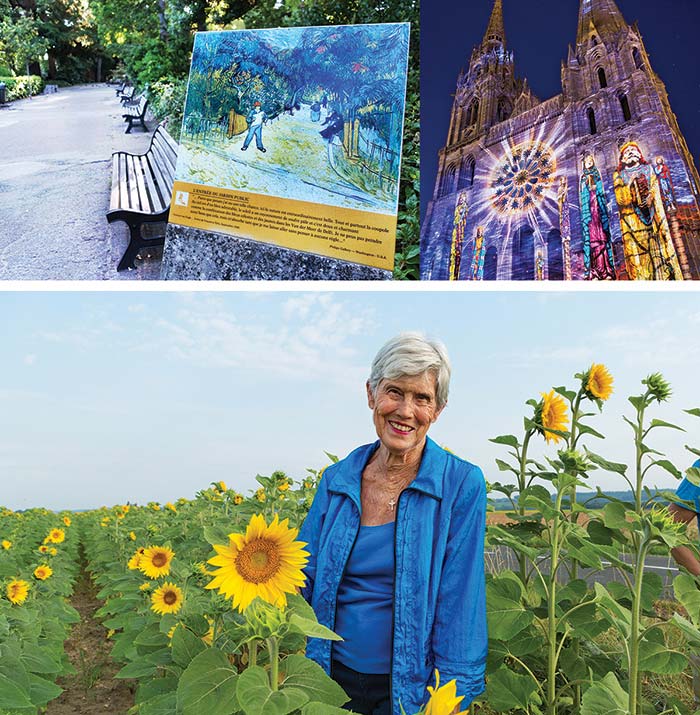
A Van Gogh easel in Arles, a sound-and-light show at Chartres, and sunflowers in summer
Winter travel is fine for Paris, Nice, and Lyon, but small cities are buttoned up tight. The weather is gray, milder in the south (unless the wind is blowing), and colder and wetter in the north. Sights keep shorter hours and some tourist activities (such as English-language tours) disappear, though hotels and restaurants are much calmer. For specifics, see the climate chart in the appendix.
Link your destinations into a logical route. Determine which cities you’ll fly into and out of (Paris and Nice can make good bookends). Begin your search for transatlantic flights at Kayak.com.
Decide if you’ll travel by car or public transportation or both. A car is useless in big cities, but a godsend for just about everywhere else. Normandy, the Dordogne, Languedoc and Provence have limited public transportation. Trains are faster and pricier than buses, though buses reach some places that trains don’t. Well-run minivan tours are listed for every region in this book.
To determine approximate transportation times between destinations, study the driving chart in the Practicalities chapter or train schedules (www.sncf.com). If France is part of a bigger trip, consider budget flights; check Skyscanner.com for intra-European flights.
Figure out how many destinations you can comfortably fit in your time frame. Don’t overdo it—few travelers wish they’d hurried more. Allow enough days per stop (see estimates in “France’s Top Destinations,” earlier). Minimize one-night stands, especially consecutive ones. It can be worth a late-afternoon drive or train ride to get settled into a town for two nights. Allot sufficient time for transportation; whether traveling by car or train, it’ll take you a half-day to get between most destinations.
Staying in a home base (such as Paris, Nice, or Amboise in the Loire) and taking day trips can be more time-efficient than changing locations and hotels.
Check the opening hours of your must-see sights; avoid visiting a town on the one day a week they’re closed. Check if any holidays or festivals will fall during your trip—these attract crowds and can close sights (for the latest, visit France’s tourist website, http://us.france.fr).
Give yourself some slack. Every trip—and every traveler—needs downtime for doing laundry, picnic shopping, people-watching, and so on. Pace yourself. Assume you will return.

Tasting wine, playing boules, and taking public transportation
You’ll have a smoother trip if you tackle a few things ahead of time. For more information on these topics, see the Practicalities chapter (and www.ricksteves.com, which has helpful tips and travel talks).
Make sure your passport is valid. If it’s due to expire within six months of your ticketed date of return, you need to renew it. Allow up to six weeks to renew or get a passport (www.travel.state.gov).
Arrange your transportation. Book your international flights early. Figure out your main form of transportation within France: You can buy train tickets as you go, get a rail pass, rent a car, or book a cheap flight. Train travelers: You’re required to make seat reservations for high-speed trains (your only option on some routes); book these as early as possible, particularly if using a rail pass, because trains can fill up and pass-holder reservations are limited.
Book rooms well in advance, especially if your trip falls during peak season or any major holidays or festivals.
Reserve or buy tickets ahead for major sights, saving you from long ticket-buying lines. Book an entry time online for the Eiffel Tower several months in advance. Some prehistoric caves in the Dordogne region take online reservations. For the greatest cave, Font-de-Gaume, there are no reservations; book a tour guide with tickets as far ahead as possible (at least six months).
Hire guides in advance. Popular guides can get booked up. If you want a specific guide, reserve by email as far ahead as possible—especially important for Paris, the D-Day beaches, Provence, and Burgundy’s wine country.
Consider travel insurance. Compare the cost of the insurance to the cost of your potential loss. Check whether your existing insurance (health, homeowners, or renters) covers you and your possessions overseas.
Call your bank. Alert your bank that you’ll be using your debit and credit cards in Europe. Ask about transaction fees, and get the PIN number for your credit card, particularly if driving (for gas stations and tollbooths). You don’t need to bring euros for your trip; you can withdraw euros from cash machines in Europe.
Use your smartphone smartly. Sign up for an international service plan to reduce your costs, or rely on Wi-Fi in Europe instead. Download any apps you’ll want on the road, such as maps, translation, transit schedules, and Rick Steves Audio Europe (see sidebar).
Rip up this book! Turn chapters into mini guidebooks: Break the book’s spine and use a utility knife to slice apart chapters, keeping gummy edges intact. Reinforce the chapter spines with clear wide tape; use a heavy-duty stapler; or make or buy a cheap cover (see the Travel Store at www.ricksteves.com), swapping out chapters as you travel.
Pack light. You’ll walk with your luggage far more than you think. Bring a single carry-on bag and a daypack. Use the packing checklist in the appendix as a guide.
If you have a positive attitude, equip yourself with good information (this book), and expect to travel smart, you will.
Read—and reread—this book. To have an “A” trip, be an “A” student. Note opening hours of sights, closed days, crowd-beating tips, and whether reservations are required or advisable. Check the latest at www.ricksteves.com/update.
Be your own tour guide. As you travel, get up-to-date info on sights, reserve tickets and tours, reconfirm hotels and travel arrangements, and check transit connections. Visit local tourist information offices (TIs). Upon arrival in a new town, lay the groundwork for a smooth departure; confirm the train, bus, or road you’ll take when you leave.
Outsmart thieves. Pickpockets abound in crowded places where tourists congregate. Treat commotions as smokescreens for theft. Keep your cash, credit cards, and passport secure in a money belt tucked under your clothes; carry only a day’s spending money in your front pocket. Don’t set valuable items down on counters or café tabletops, where they can be quickly stolen or easily forgotten.
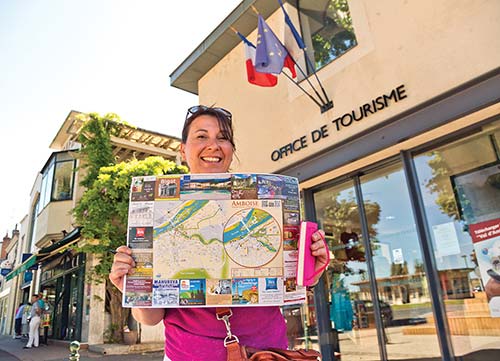
Minimize potential loss. Keep expensive gear to a minimum. Bring photocopies of important documents (passport and cards) to aid in replacement if the originals are lost or stolen. Back up photos and files frequently.
Guard your time and energy. Taking a taxi can be a good value if it saves you a long wait for a cheap bus or an exhausting walk across town. To avoid long lines, follow the crowd-beating tips in this book, such as making advance reservations or sightseeing early or late.
Be flexible. Even if you have a well-planned itinerary, expect changes, strikes, closures, sore feet, bad weather, and so on. Your Plan B could turn out to be even better.
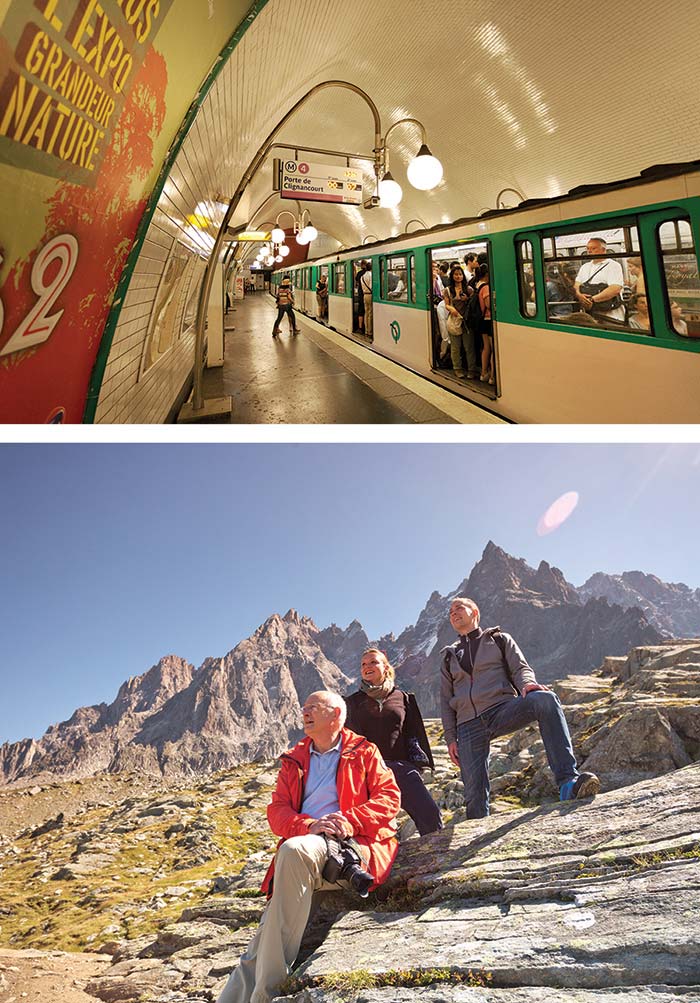
Going underground in Paris and on top of the world in the French Alps
Attempt the language. The French appreciate your effort. If you learn even just a few phrases, you’ll get more smiles and make more friends. See the sidebar on here for tips.
Connect with the culture. Interacting with locals carbonates your experience. Enjoy the friendliness of the French people. Ask questions; most locals are happy to point you in their idea of the right direction. Set up your own quest for the best croissant, sidewalk café, hill town, or the château you’d like to call home. When an opportunity pops up, make it a habit to say “yes.”

France...here you come!